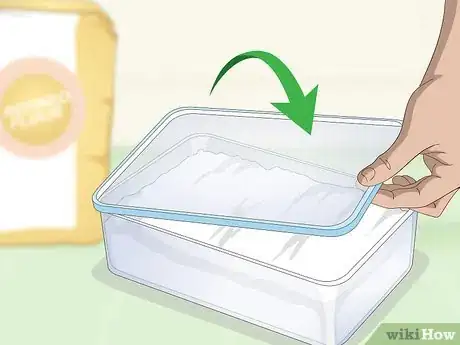This article was co-authored by wikiHow Staff. Our trained team of editors and researchers validate articles for accuracy and comprehensiveness. wikiHow's Content Management Team carefully monitors the work from our editorial staff to ensure that each article is backed by trusted research and meets our high quality standards.
This article has been viewed 56,269 times.
Learn more...
There are several variables, such as moisture, heat, and bugs, that can greatly impact the quality of your flour. Different types of flour have different shelf lives, and learning how to store each one is important when getting the most out of your flour. By following strategies, such as using airtight containers and keeping your flour in a cool, dry spot, you will be able to store your flour efficiently.
Steps
Storing Refined Flours
-
1Transfer refined flours into a sealed container. Refined flours, such as self-rising, all-purpose, pastry, and bread flours, are the most commonly used. Because you may use this flour often, it should be stored in a sealed container that prevents air, moisture, and bugs from getting into the flour.[1]
- Dry storage containers, Ziploc bags, and sealed buckets are all good options for storing flour.
-
2Store refined flour in a cool, dry place. Refined flours have a shelf life of 1-2 years, so as long as they are stored in a cool, dry spot. Put your container of flour in a cabinet or the pantry.[2]Advertisement
-
3Look for a sour scent to indicate rancid flour. If you are worried that your flour has turned rancid, smell it to see if it is still fresh. Refined flours tend to smell sour when they have gone bad.[3]
Storing Specialty Flours
-
1Place whole grain, nut, and alternative flours in the freezer for long-term storage. Whole grain flours, like barley, wheat, quinoa, millet, and oat flour, have a shelf life of a few months. Nut and alternative flours spoil even faster than whole grain flours because they contain a lot of oil. If you want to keep them fresh longer, store these flours in the freezer, so that the oil in the flour will not oxidize as quickly when exposed to air.[4]
- If you store these types of flour in the refrigerator, you will extend their shelf life to six months, whereas storing them in the freezer extends freshness to 12 months.
- Transfer the flour to an airtight container before freezing it.
-
2Store flour that does not contain whole grains and starches in a cabinet. These types of flour can stay fresh your pantry or cabinet for at least a year, and often longer. Make sure the flour is in a dry storage container or sealed bucket if it will potentially be stored for a long period of time.[5]
- Store these flours in a dry storage container or in sealed plastic bags placed in your freezer.
-
3Look for an unpleasant odor to signal the flour went bad. Smelling your flour is the best way to check to see if it is still fresh. When you first buy your flour, smell it to recognize what it should smell like when it's fresh. When flour has gone bad, it can have a range of unpleasant odors depending on the exact type of flour it is. The most common odors have a sour or fermented smell.[6]
- Whole grain flours smell like burnt rubber when they have turned rancid.
- Alternative flours will taste bitter when they have gone bad. When the flour is fresh, it should smell sweet.
Keeping Your Flour Fresh
-
1Use your flour by its expiration date. While some expiration dates may be flexible, the date is there in compliance with food regulations. It is a good indicator of when it is time to get rid of your flour. When buying new flour, check the expiration date before you leave the store for two reasons:
- To ensure you are purchasing fresh product, and
- To help you decide the size of bag to purchase, so that you can use it up close to the expiry date.[7]
-
2Store your flour in an airtight or sealed container. To ensure that moisture, air, and bugs do not get into your flour, store each type in an airtight container. These can be found at any superstore or home goods store, as well as online.[8]
- Dry storage containers are the most popular choice for storing flour, but you can also separate your flour into plastic bags and store it in a sealed bucket.
- Vacuum seal your flour to prevent air from spoiling it.
- You can store flour in its original paper sack by thoroughly wrapping the sack with plastic wrap, then putting the flour in the refrigerator freezer for long-term storage.
-
3Fill the airtight container as full as possible. The more air that is in your container, the quicker the chances are of your flour turning bad. To keep this from happening, put as much flour as possible into your airtight container before sealing it.[9]
- Transfer your flour to a smaller container once you've used up a significant amount.
-
4Place your sealed flour in a cool, dark place. Flour goes rancid quickly when left out in the sun or a warm, bright spot. Find a cool, dark place to put your container of flour, such as a pantry or cabinet. Keep the flour away from appliances that get hot as well, such as stoves, ovens, and microwaves.[10]
- The shelf life of flour is based on how long it can sit in this cool, dark environment. If your flour’s shelf life is 1-2 years, it should be fine sitting in a pantry or cabinet for this amount of time.
-
5Put your flour in the refrigerator or freezer for long-term storage. The shelf life of flour can be extended if you keep your flour in the fridge, and even longer in the freezer. Make sure your flour is properly sealed before putting it in the refrigerator or freezer so that moisture does not creep in.[11]
- If you bought flour in bulk and know you will not be using all of it for a while, the freezer is a great place to store it. As you do not have packaging with an expiry date on bulk purchases, it is best if you purchase amounts you plan to use in short order.
References
- ↑ http://www.thekitchn.com/a-complete-guide-to-storing-your-flour-204729
- ↑ http://www.thekitchn.com/a-complete-guide-to-storing-your-flour-204729
- ↑ https://food52.com/blog/15993-the-best-way-to-store-all-sorts-of-flours
- ↑ http://www.thekitchn.com/a-complete-guide-to-storing-your-flour-204729
- ↑ https://food52.com/blog/15993-the-best-way-to-store-all-sorts-of-flours
- ↑ http://www.thekitchn.com/a-complete-guide-to-storing-your-flour-204729
- ↑ https://food52.com/blog/15993-the-best-way-to-store-all-sorts-of-flours
- ↑ http://www.thekitchn.com/a-complete-guide-to-storing-your-flour-204729
- ↑ http://www.recipetips.com/kitchen-tips/t--1039/flour-storage-guide.asp
About This Article
To store refined flour like all-purpose flour, put it in a sealed container in a cool, dry place like a cabinet for 1-2 years. Plastic storage bags and food grade buckets work well, but make sure any container you use is as close to full as possible so there is less air inside. When you use the flour, make sure it doesn't have a sour scent, which would mean the four is rancid. To store specialty grains like whole grain flour, transfer the flour to an airtight container and freeze it for up to 12 months. If you want to learn how to refrigerate or freeze your flour, keep reading the article!

























































